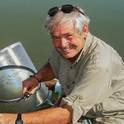Thesis
Spatial and temporal dynamics of phytoplankton living in deep chlorophyll maxima: Effects of light, nutrients, herbivore grazing, and herbivore recycling as growth determinants
(2001)
Abstract
Deep chlorophyll maxima (DCM) are a common feature of oligotrophic lakes, yet the mechanisms that form and maintain them are not understood. Factorial microcosm experiments were performed in two oligotrophic, high-mountain lakes in Idaho to consider physical, chemical, and biological mechanisms that influence DCM. In-situ experiments from three depth strata were done with enriched light and nutrient treatments, and with and without the natural zooplankton grazers. Macronutrient limitation occurred though the summer in the epilimnia; however, phytoplankton in the DCM were never nutrient limited. In the lakes alkaline phosphatase activity increased throughout the summer, but metalimnetic algae consistently demonstrated less phosphorus limitation. Direct (grazing) and indirect (recycling) macrozooplankton effects varied with depth and time but were also important factors for DCM growth. Top-down and bottom-up effects interact within these lakes to provide an optimal habitat in the metalimnion for phytoplankton to accumulate.
Disciplines
Publication Date
2001
Degree
Master of Science
Field of study
Aquatic Ecology
Department
Utah State University, Fisheries and Wildlife
Advisor
Wayne Wurtsbaugh
Citation Information
Cornelia L. Sawatzky. "Spatial and temporal dynamics of phytoplankton living in deep chlorophyll maxima: Effects of light, nutrients, herbivore grazing, and herbivore recycling as growth determinants" (2001) Available at: http://works.bepress.com/wayne_wurtsbaugh/314/
